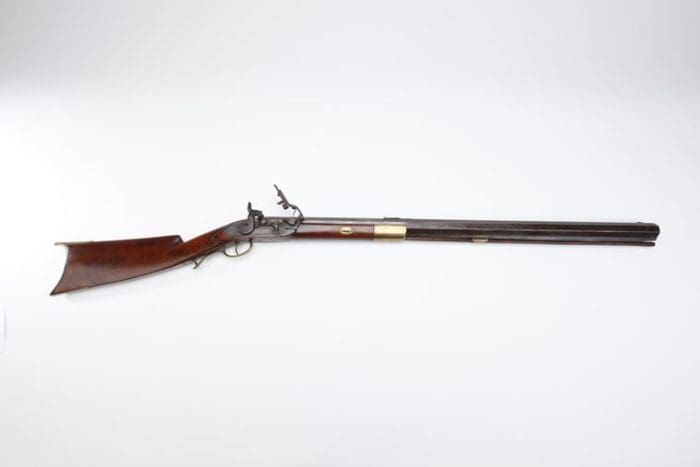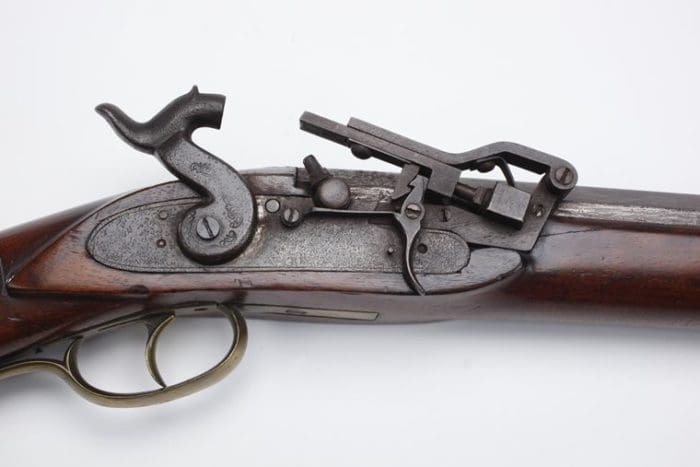
The major drawback of any muzzleloading firearm has always been that you only get one shot before needing to reload. If you could get off three shots in a minute, you were doing really well.
One way to get more out of your muzzleloader was to adapt it for superposed charges. That is, multiple loads of powder and projectile stacked on top of one another. In some primitive examples, all of the superposed charges would ignite one after another like a Roman candle firework. Other examples offered a little more control.
The maker of this percussion rifle isn’t known, but he came up with an innovative device. An extra attachment was added at the front of the standard percussion lock. A spring positioned a hammer extension over a second cap and cone, which was held in place with a second trigger-activated latch.

In order to fire the rifle safely, the extra attachment on the lock must be discharged first. After firing the first bullet, a clear path of ignition for the second charge is now available. Firing the gun in the opposite order is a self-correcting error, as there will be too much pressure in the barrel and the gun will most certainly explode.

To fire the second shot, simply pull the secondary trigger to release the extra attachment, getting it out of the way. Then, cock the hammer as normal and pull the trigger. This will drop the hammer, igniting the cap on the traditional cone.
Was it the best solution? Probably not; it certainly did nothing for the aesthetics of the gun. Nonetheless, it was indeed a working solution to the single-shot dilemma.
(Firearm courtesy NRA Museums)
Logan Metesh is a firearms historian and consultant who runs High Caliber History LLC. Click here for a free 3-page download with tips about caring for your antique and collectible firearms.




I’ll take a NY reload over that bomb waiting to happen.
Pretty soon a NY reload is going to be renocking an arrow.
It’s black powder. If you blow it up, you were trying to do so.
There’s an interesting demonstration of this on YouTube (unless it’s been taken down) where the guy making it loaded up a muzzle loader with double, then triple charges. Tried multiple balls. The only thing that caused it to split the barrel was to plug the majority of the barrel.
But remember, all those videos of how tough it is to blow up a firearm with black powder are done with modern reproduction guns. Modern steels are multiple times tougher than the actual guns were, back in the day.
There were many repeating flintlock and percussion rifles the most well known probably being the Cookson. The Belton used superposed loads like you’re talking about. There were others. A better early repeater though was the one Lewis & Clark took to the Pacific and back the Girandoni air rifle. Napoleon considered it a weapon of assassins and ordered any captured soldier with one executed.
I like the so-called “turret revolver action” guns – not because they worked well or were even safe… They just looked cool.
🤠
Wait, there were fully semi-automatic weapons back in the musket era? Unpossible! Did the dems lie? Again? Still?
Well they weren’t semi-automaic but they were indeed repeaters. The Girandoni air rifle was something else. No smoke, little noise and carried 20 rounds. Lewis & Clark demonstrated it to nearly all the tribes they met and some people credit the Girandoni for keeping the expedition safe from attack. Not because they used it against any tribes but because the tribes didn’t know how many of these wonder weapons the expedition had. It was a deterrent.
The other thing about it was that it was a rifle not a smoothbore musket so accuracy was much better. Alas it was not that powerful nor durable and took forever to pump up once its 30 shot air tank was exhausted. Not to mention that being caught with one meant the firing squad if captured by the French.
Look up “puckle gun.”
There were essentially machine guns (gatling type) as far back as 1713.
Scorpions sting, Leftists lie. It’s their basic, essential nature.
N.R.A. and Trump have requested the ‘ color of law ‘ agency called B.A.T.F. to take a second look at this device.
Public comments will be shredded , similar guns will be delivered to drug cartels.
Ian on fw has shown an example with 4 or 5 complete locks that thing was a mess. I’m not sure a double load would be a bomb. Iv8888 has a pretty intense video of them trying to blow up a muzzle loader with double and triple loads as well as other ridiculous things. I was surprised at how much it took to destroy
My muzzleloaders have all had multiple shots fired from them… one at a time…
Now I do use pre-measured loads in these little plastic tubes from Uncle Mike’s – I think they still make them.
🤠
Eh, if the rifle was adapted to do this, is it no longer a “Single-Shot Muzzleloader?…
True.
It would then be defined as a repeater… albeit a very dangerous one.
18th Century Full Auto.
“18th Century Full Auto.”
That actually existed –
https://www.youtube.com/watch?v=cbvbLCs7iJ4
Geoff there was also the puckle gun which operated in a similar fashion to the gatling gun only it was a matter of changing barrel sets to reload fast otherwise as with the 32 barrel one in your video it was similar in reloading time per barrel.
If you could get three rounds a minute off with a flint lock Baker rifle you were one of Richard Sharpe’s Chosen Men. You got to wear a green jacket and shoot Frenchmen. I can just do three rounds a minute on a good day with a percussion Hawken style carbine, loading with prepared charges and sabot pistol bullets. I definitely wouldn’t trust one of those Roman candle style rifles. An over and under or side by side which did exist in those days would be a much safer, although heavier, choice.
There were plenty of double barrel shotguns that could shoot buck and ball–a deadly combination at close range. The same combination out of a musket was good for 100-200 yards agaisnt massed troops.
I propose modifying the weapon to load from the breech, and using a metallic “cartridge” of some kind, containing a primer, powder and bullet all in one. You could then devise some form of mechanized reciprocating action to remove fired cartridges and insert fresh ones from a spring-loaded storage chamber, or perhaps a wheel-like rotating block that held multiple cartridges and aligned them with the barrel…
Pffth… You silly kids and your newfangled contraptions…
🤠
I think you are on to something, I would draw something up on paper and head down to the patent office ASAP
You could increase the rate of fire by tap loading. The French reportedly used this tactic at Waterloo.
This one was a bit cumbersome. It could have been used with great effect if not for the negatives mentioned in the article.
https://en.wikipedia.org/wiki/Ferguson_rifle
acquire your target and shoot straight the first time….there….problem solved
Comments are closed.